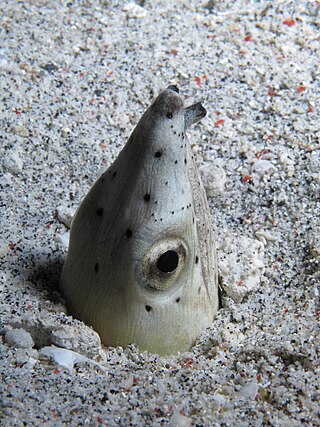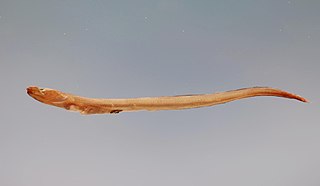The Pacific worm eel is an eel in the family Ophichthidae. It was described by David Starr Jordan and Charles Henry Gilbert in 1883. It is a marine, subtropical eel which is known from the eastern central and southeastern Pacific Ocean, including California, USA, Colombia, Costa Rica, El Salvador, Ecuador, Honduras, Mexico, Guatemala, Panama, Nicaragua, and Peru. It dwells at a depth range of 1 to 12 metres, and inhabits sand and mud sediments. Unlike many species of eel, it does not form burrows. Males can reach a maximum total length of 46 centimetres.
The Pacific spoon-nose eel is an eel in the family Ophichthidae. It was described by José Luis Castro-Aguirre and Sergio Suárez de los Cobos in 1983, originally under the genus Notophtophis. It is a marine, tropical eel which is known from the eastern central and southeastern Pacific Ocean, including the Gulf of California, Colombia, Mexico, Costa Rica, Nicaragua, Ecuador and Panama. It dwells at a maximum depth of 10 metres (33 ft), and inhabits sand and mud sediments. Males can reach a maximum total length of 140 centimetres (55 in), but more commonly reach a TL of 60 centimetres (24 in).
The smiling snake eel is an eel in the family Ophichthidae. It was described by David Starr Jordan and Charles Henry Gilbert in 1882, originally under the genus Apterichthys. It is a marine, tropical eel which is known from the eastern central and southeastern Pacific Ocean, including Colombia, Costa Rica, Panama, Ecuador, and Mexico. It dwells at a maximum depth of 30 metres (98 ft), and inhabits sediments of sand. Males can reach a maximum total length of 41 centimetres (16 in).
The Oriental worm-eel, also known as the Oriental snake eel, the Oriental sand-eel or the finny sand-eel, is an eel in the family Ophichthidae. It was described by John McClelland in 1844, originally under the genus Dalophis. It is a tropical, marine and freshwater-dwelling eel which is known from the Indo-Western Pacific, including Somalia, South Africa, India, Papua New Guinea, Tahiti, French Polynesia, Indonesia, Oman, Palau, New Caledonia, the Philippines, Sri Lanka, Seychelles, and Vanuatu. It dwells at a depth range of 0 to 3 metres, and forms burrows in sand and mud sediments in estuaries, rivers, and inshore turbid waters. Males can reach a maximum total length of 36 centimetres (14 in), but more commonly reach a TL of 25 centimetres (9.8 in).
The Sailfin snake-eel is an eel in the family Ophichthidae. It was described by John E. McCosker in 1974. It is a marine, tropical eel which is known from the eastern central and southeastern Pacific Ocean, including Colombia, Ecuador, Costa Rica, Panama and Mexico. It dwells at a depth range of 0 to 17 metres, and inhabits sand sediments. Males can reach a maximum total length of 31 centimetres (12 in).
The longfin spotted snake eel is an eel in the family Ophichthidae. It was described by John E. McCosker and Richard Heinrich Rosenblatt in 1993. It is a marine, tropical eel which is known from Mexico, Costa Rica and Panama, in the eastern central Pacific Ocean. It dwells at a depth range of 44 to 64 metres, and inhabits sandy substrates. Males can reach a maximum total length of 51 centimetres.

The spotted snake eel, also known as the tiger snake eel or the spotted tiger snake eel, is an eel in the family Ophichthidae. It was described by Charles Frédéric Girard in 1859. It is a marine, tropical eel which is known from the eastern central and southeastern Pacific Ocean, including Chile, Costa Rica, Colombia, El Salvador, Ecuador, Mexico, Guatemala, Nicaragua, Panama, Honduras, and Peru. It dwells at a depth range of 0 to 60 metres, and inhabits benthic sediments of mud and sand. Males can reach a maximum total length of 74 centimetres (29 in), but more commonly reach a TL of 60 centimetres (24 in).

The highfin snake eel (Ophichthus altipennis, also known as the blackfin snake eel or the black-finned snake eel, is an eel in the family Ophichthidae. It was described by Johann Jakob Kaup in 1856, originally under the genus Microdonophis. It is a marine, tropical eel known from the eastern Indian Ocean and northwestern and western central Pacific Ocean, including Australia, French Polynesia, Indonesia, Japan, the Marshall Islands, Malaysia, the Philippines, and Papua New Guinea. It dwells at a depth range of 0 to 40 m, and forms burrows in soft inshore sand sediments. Males can reach a maximum total length of 103 cm.
The thin snake eel is an eel in the family Ophichthidae. It was described by John E. McCosker and Richard Heinrich Rosenblatt in 1998. It is a marine, tropical eel known from the eastern central and southeastern Pacific Ocean, including Mexico and Colombia. It is known from two specimens observed dwelling in sand at a depth range of 0 to 8 m. The maximum length recorded was 23.1 cm (9.1 in), albeit on an immature specimen.
The death-banded snake eel is an eel in the family Ophichthidae. It was described by Samuel Garman in 1899. It is a tropical, marine eel which is known from the eastern central and southeastern Pacific Ocean, including the central Gulf of California, Colombia, Costa Rica, Mexico and Panama. It dwells at a depth range of 35–760 metres, and forms burrows in sandy and muddy bottoms. Males can reach a maximum total length of 86 centimetres.
Ophichthus longipenis, known commonly as the slender snake eel in Mexico, is an eel in the family Ophichthidae. It was described by John E. McCosker and Richard Heinrich Rosenblatt in 1998. It is a marine, tropical eel which is known from the eastern central Pacific Ocean, including Mexico, El Salvador, Guatemala, Honduras, Nicaragua, Costa Rica and Panama. It dwells at a depth range of 0 to 69 metres, and inhabits sand sediments. Males can reach a maximum total length of 58.7 centimetres (23.1 in).
The longarmed snake eel is an eel in the family Ophichthidae. It was described by John E. McCosker and Richard Heinrich Rosenblatt in 1998. It is a marine, tropical eel which is known from the eastern central Pacific Ocean, including Mexico, Costa Rica, El Salvador, Guatemala, Nicaragua, and Panama. It is known to dwell at a depth range of 24 to 79 metres, and inhabits soft substrates. Males can reach a maximum total length of 27.4 centimetres (10.8 in).

The blackpored eel is an eel in the family Ophichthidae. It was described by Robert H. Kanazawa in 1963. It is a tropical, marine eel which is known from the western central Atlantic Ocean, including Florida, USA; the Bahamas, and Mexico. It dwells at a depth range of 51–460 meters. While the adults inhabit deep water, the larvae are laid inshore. Males can reach a maximum total length of 70 centimeters.
Ophichthus melope is an eel in the family Ophichthidae. It was described by John E. McCosker and Richard Heinrich Rosenblatt in 1998. It is a marine, tropical eel which is known from the eastern central and southeastern Pacific Ocean, including Colombia and Costa Rica. It dwells at a depth range of 100 to 224 metres. Males can reach a maximum total length of 27 centimetres (11 in).
The rufus snake eel is an eel in the family Ophichthidae. It was described by Constantine Samuel Rafinesque in 1810, originally under the genus Echelus. It is a marine, subtropical eel which is known from throughout the Mediterranean and the Black Sea, in the northeastern Atlantic Ocean, including Algeria, Albania, Croatia, Egypt, France, Cyprus, Gibraltar, Greece, Italy, Israel, Montenegro, Lebanon, Libya, Malta, Morocco, Monaco, Slovenia, Spain, Tunisia, the Syrian Arab Republic, and Turkey. It inhabits mud sediments on the continental shelf. Males can reach a maximum total length of 60 centimetres (24 in).
The wrinkled snake eel is an eel in the family Ophichthidae. It was described by David Starr Jordan and Charles Harvey Bollman in 1890. It is a marine, tropical eel which is known from the eastern central and southeastern Pacific Ocean, including the Galapagos Islands and the Cocos Islands. It is also speculated to occur in Malpelo Island. It is known to dwell at a depth of 200 metres (660 ft), and inhabits sediments of sand and rubble. Males can reach a maximum total length of 68 centimetres (27 in).

The Pacific snake eel is an eel in the family Ophichthidae. It was described by Johann Jakob Kaup in 1856, originally under the genus Muraenopsis. It is a marine, subtropical eel which is known from the eastern central and southeastern Pacific Ocean, including California, USA, Peru, the Gulf of California, Mexico, the Galapagos Islands, Colombia, Ecuador, Costa Rica, El Salvador, Honduras, Guatemala, Nicaragua, and Panama. It dwells at a maximum depth of 155 metres (509 ft), and forms burrows in mud and sand sediments. Males can reach a maximum total length of 115 centimetres (45 in), but more commonly reach a TL of 80 centimetres (31 in).
The yellow snake eel is an eel in the family Ophichthidae. It was described by David Starr Jordan and Charles Henry Gilbert in 1882. It is a marine, subtropical eel known from the eastern central and southeastern Pacific Ocean, including Chile, Costa Rica, Colombia, Ecuador, Guatemala, El Salvador, Honduras, Nicaragua, Mexico, Panama, Peru, and the United States. It dwells at a depth range of 1 to 110 m, and forms burrows in rocky and sandy regions. Males can reach a maximum total length of 818 cm (322 in), but more commonly reach a length of 540 cm (210 in).

The rice-paddy eel is an eel in the family Ophichthidae. It was described by Francis Buchanan-Hamilton in 1822, originally in the genus Ophisurus. It is a tropical, marine eel which is known from the Indo-West Pacific, including Somalia, Tanzania, South Africa, southern India, Sri Lanka, Indonesia, Polynesia, Australia, Bangladesh, Cambodia, Kenya, Madagascar, the Philippines, Malaysia, Mozambique, Seychelles, Saudi Arabia, Taiwan, China, Thailand, Vietnam, and southern Yemen. It is an anadromous species and spawns in freshwater, often in rice paddies during the rainy season, earning it its common name. It also spends time in lagoons, estuaries and coastal rivers, in which it lives in burrows in the river bottom and bank. Males can reach a maximum total length (TL) of 100 centimetres, but more commonly reach a TL of 70 cm.
The smallfish snake eel is an eel in the family Ophichthidae. It was described by Charles Henry Gilbert in 1890. It is a marine, tropical eel which is known from the eastern central Pacific Ocean, including Mexico, Nicaragua, Panama, the Gulf of California and Costa Rica. It dwells in shallow waters at a maximum depth of 20 metres (66 ft), and inhabits sand and rock sediments. Males can reach a maximum total length of 70 centimetres (28 in).





